
Steve Jackson Games (SJGames) is a game company, founded in 1980 by Steve Jackson, that creates and publishes role-playing, board, and card games, and the gaming magazine Pyramid.
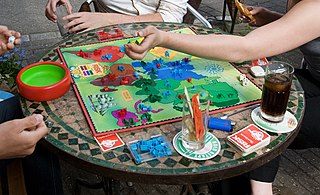
Risk is a strategy board game of diplomacy, conflict and conquest for two to six players. The standard version is played on a board depicting a political map of the world, divided into 42 territories, which are grouped into six continents. Turns rotate among players who control armies of playing pieces with which they attempt to capture territories from other players, with results determined by dice rolls. Players may form and dissolve alliances during the course of the game. The goal of the game is to occupy every territory on the board and, in doing so, eliminate the other players. The game can be lengthy, requiring several hours to multiple days to finish. European versions are structured so that each player has a limited "secret mission" objective that shortens the game.
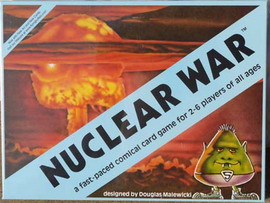
Nuclear War is a collectible common-deck card game designed by Douglas Malewicki and originally published in 1965 that is a satirical simulation of an end-of-the-world scenario fought mostly with nuclear weapons. It is currently published by Flying Buffalo, and has inspired several expansions.
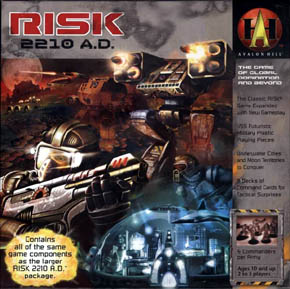
Risk 2210 A.D. is a 2–5 player board game by Avalon Hill that is a futuristic variant of the classic board game Risk. Risk 2210 A.D. was designed by Rob Daviau and Craig Van Ness and first released in 2001. In 2002, it won the Origins Award for "Best Science Fiction or Fantasy Board Game of 2001".
The Gamemaster Series of board games consists of five war simulation games released by the game company Milton Bradley beginning in 1984. The games were not developed "in-house" by Milton Bradley, with each game initially published in limited runs by smaller game publishers in the early 1980s before their rights were acquired by Milton Bradley. Despite this, some modern reissues of these games refer to the Milton Bradley versions as the "first edition" of each game.

Shogun is a board wargame set in feudal Japan, first released in 1986 by game maker Milton Bradley.

White Bear and Red Moon is a fantasy board wargame set in the world of Glorantha, created by Greg Stafford and published in 1975. Stafford first tried to sell the game to established publishers, but despite being accepted by three different game companies, each attempt ended in failure; eventually he founded his own game company in 1974, the influential Chaosium, to produce and market the game.

The Russian Campaign is a strategic board wargame published by Jedko Games in 1974 that simulates combat on the Eastern Front during World War II. Avalon Hill later bought the game and produced several editions.
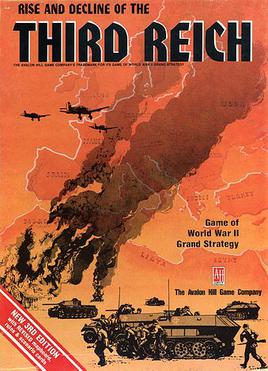
Rise and Decline of the Third Reich or more commonly Third Reich is a grand strategy wargame covering the European theater of World War II, designed by John Prados and released in 1974 by Avalon Hill. Players take on the roles of major powers—Germany, Italy, United Kingdom, France, the Soviet Union, and the United States—from 1939 to 1946.
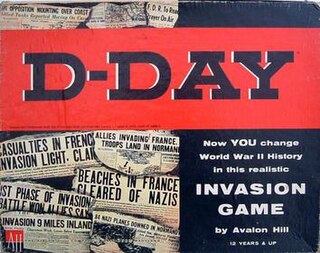
D-Day is a board wargame published by Avalon Hill in 1961 that simulates the six months of the European Campaign of World War II from the Normandy Invasion to the crossing of the Rhine. It was the first wargame to feature the now ubiquitous hex grid map and cardboard counters, and was revised and re-released in 1962, 1965, 1971, 1977 and 1991.

Supremacy: The Game of the Superpowers is a political, economical, and military strategic board wargame published in 1984 by Supremacy Games, and designed by Robert J. Simpson.

Invasion: America, subtitled "Death Throes of the Superpower", is a near-future board wargame published by SPI in 1976 that simulates a hypothetical coordinated attack on North America by various factions.

Tactics is a board wargame published in 1954 by Avalon Hill as the company's first product. Although primitive by modern standards, it and its sequel, Tactics II, signalled the birth of modern board wargaming for the commercial market. Tactics is generally credited as being the first commercially successful board wargame.

Revolt On Antares is a science fiction themed microgame designed by Tom Moldvay and produced by TSR, Inc. in 1981. Similar to the microgames produced by Steve Jackson Games, it was sold in a transparent plastic shell case and came with rulebook, full-color hex-map, counters, and one six-sided die. Other games in this series include They've Invaded Pleasantville!, Remember the Alamo, Attack Force, Vampyre, Viking Gods, Icebergs and Saga.

Paths of Glory: The First World War, 1914–1918 is a strategy board wargame, designed in 1999 by the six-time Charles S. Roberts Awards winner Ted Raicer and published by GMT Games. It covers World War I from its outbreak to the 1918 Armistice, or based on the progress of the game a hypothetical later ending of the war in early 1919, possibly due to exhaustion of Europe. The game is played on a map of Europe and the Middle East as the game board.

A board wargame is a wargame with a set playing surface or board, as opposed to being played on a computer or in a more free-form playing area as in miniatures games. The modern, commercial wargaming hobby developed in 1954 following the publication and commercial success of Tactics. The board wargaming hobby continues to enjoy a sizeable following, with a number of game publishers and gaming conventions dedicated to the hobby both in the English-speaking world and further afield.

Diplomacy is a strategic board game created by Allan B. Calhamer in 1954 and released commercially in the United States in 1959. Its main distinctions from most board wargames are its negotiation phases and the absence of dice and other game elements that produce random effects. Set in Europe in the years leading to the First World War, Diplomacy is played by two to seven players, each controlling the armed forces of a major European power. Each player aims to move their few starting units and defeat those of others to win possession of a majority of strategic cities and provinces marked as "supply centers" on the map; these supply centers allow players who control them to produce more units. Following each round of player negotiations, each player can issue attack and support orders, which are then executed during the movement phase. A player takes control of a province when the number of provinces that are given orders to support the attacking province exceeds the number of provinces given orders to support the defending province.
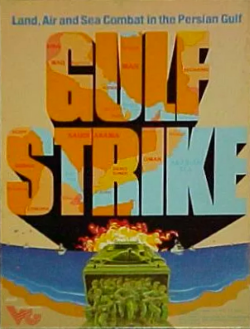
Gulf Strike, subtitled "Land, Air and Sea Combat in the Persian Gulf", is a board wargame published by Victory Games in 1983. The first and second editions were hypothetical games focussed on American responses to Iranian aggression in the Persian Gulf. The third edition, published in 1990, was updated to reflect the reality of Operation Desert Shield during the Gulf War.

Invasion: Sicily – Alexander vs Kesselring is a board wargame published by Rand Game Associates in 1974 that simulates the Allied invasion of Sicily during World War II.
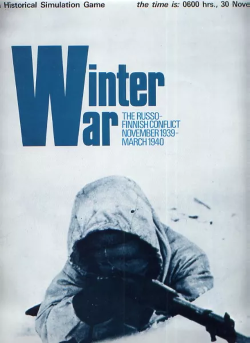
Winter War: The Russo-Finnish Conflict is a board wargame published by Simulations Publications Inc. (SPI) in 1972 that simulates the Soviet Union's 1939 invasion of Finland during World War II.




















